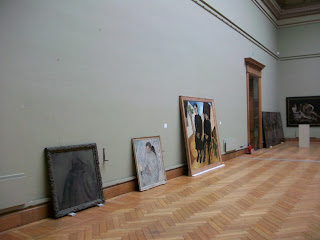Hello All,
all the MA students have been thinking about Foucault (again) the past few weeks - and whether such opaque ideas are useful at all, (at least for us in thinking about 'museum studies')...(the answer is of course it is!) In relation to this I thought I'd draw your attention to a recent exhibition I went to at the Royal Museum of the Fine Arts, Antwerp. Closing Time, curated by the Belgian artist Jan Vanriet - (it's unfortunately 'closed' now...I didn't hear if they called 'last orders'.....) -Closing Time is an interesting example of the complex ways in which museums and galleries are 're-thinking' the classifications, conjunctions and narratives of their collections; (perhaps in a 'Foucauldian' way...or perhaps we've always done such things...and..doesn't assigning this process a 'name' subvert the intentions of such a project?...what, indeed, is 'an author' in this context?)
Anyway, Vanriet is a well known Belgian artist (I confess I'd not heard of him...but I'm not usually in such 'loops'..I'll avoid the cliche of 'famous Belgians'...oh I didn't..sorry!). Vanriet had been given carte-blanche in choosing artworks from the permanent collections of the Royal Museum of the Fine Arts and re-assembled them in the temporary exhibition spaces, setting up conjunctions with his own works and disrupting the conventional taxonomies and classifications of the artworks in the gallery. As you can see (here), paintings by 'masters' such as Hans Memling (Man with a Roman Coin c.1478) are set in dialogue with the works of Vanriet (Eva, Black Bonnet, 2006). One can see 'echoes' in these conjunctions - across time, across cultures, across visual memory. I confess it was a beautiful exhibition - a taxonomy of poetics, instead of the 'hard science' of art history..(perhaps); and the exhibition was packed with visitors!
But.....there are, of course, 'consequences' for such interventions; I arrived at the gallery very early on a Sunday morning, and accidentally wandered into the (closed to the public) spaces of the permanent collections, from which Vanriet had rummaged and taken his choice. I was eventually, and very politely, ushered out of these spaces by the security guy, but had managed to wander through quite a few rooms before being 'caught'.
Unlike the Closing Time exhibition (which was downstairs), the spaces in the permanent galleries were rather sad. Paintings left, forlorn, and propped up against the walls, many swathed in bubble-wrap (this was not just as a consequence of Vanriet's interventions, but also in preparation for the closure of the gallery, which is to undergo a refurbishment for the next 2 years). But I was struck by the empty spaces on the walls alongside the artworks. 'Holes' in art history if you like - perhaps an inevitable consequence of the re-invigorating 'presence' in the Closing Time exhibition is this 'absence' - but then I suppose such effects are more than a 'necessary consequence' of the disruption of conventions, they are also a 'neccessity'!
Mark
Welcome to the Leeds University Museum Studies Blog. Here you can follow the activities, conversations and debates associated with the University's School of Fine Art, History of Art and Cultural Studies courses. We envisage it as an informal space for museum-related discussion, interests & the sharing of ideas. To join the conversation click the 'Get involved!' tab. We hope you enjoy it! Rosa and Mark
Search the blog
Subscribe to:
Post Comments (Atom)


No comments:
Post a Comment